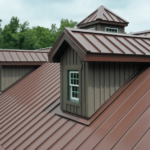Spring is on the horizon. You can almost feel the heat beating down on your shoulders. And just as you’re looking up, hoping to catch some of those sun rays, you just might find you’re actually surprised at what you see. You might see signs of snow damage to your roof.
Here are some common signs.
1. Damaged Shingles
Shingles that have disappeared or now look rough, split, or cracked are all signs of a roof damaged by snow. As it melts, water can build up and improperly drain or leak. This can cause a multitude of problems such as bug infestations or mold growth.
2. Warped Walls
Another sign of a snow-damaged roof is a wet attic, damp walls, or paint that has air bubbles under it. These are all likely to be the result of snow melting and leaking from the roof.
3. Downed Tree Branches
This is another sign your roof may have sustained damage. Large branches are likely to be heavy, and the weight of a snowstorm may pull them down onto your roof and cause damage.
4. Clogged Gutters
With a gutter that’s blocked, the water from snow melting simply has no place to go, and it can’t properly drain. It stays put and stagnates on your roof. The weight of the water builds up, attracts bugs and mold, and emits a rotting odor.
5. Lingering Snow and Ice
Lingering snow and ice is an indicator of a long hard winter with heavy snowfall. The longer it’s there, the more time it has to build up and cause damage. It’s something you’ll want to take into consideration when you’re evaluating your roof as spring begins.
How to Prevent and Fix Snow Damage
While it might not help you immediately, prevention is always preferred over a repair job. At the start of winter and all throughout the season, ensure that your gutters are clear of debris, leaves, sticks, rocks etc. This will allow room for any snow to melt, and then the resulting water will have a way to drain properly, instead of pooling on your rooftop.
Trimming away any heavy tree branches or limbs before the start of winter is a good idea too. After all, if a branch isn’t there to begin with, it can’t fall on your roof!
Check your shingles before a single flake falls. If they look beaten up now, snow will only make matters worse. Naturally, that could be hard on your roof. Get them checked before the temperatures drop, and you might be able to prevent further damage.
If your roof can’t handle lingering snow and ice, winter could be harmful to it. If you want to be sure this isn’t the case, have your entire roof professionally inspected before the start of winter. This will let you know how much snowfall your roof can withstand so you can develop a prevention plan. Better safe than sorry!
Another way to keep snow from building up on your roof is by using heated coils. These work to raise the temperature on top of the roof so the snow melts quickly rather than building up. Since it’s the weight of snow that has potential to cause a great deal of damage, anything that can melt it quickly is something you should consider investing in.
Fix it
What if the worst does happen? What if your roof does sustain snow damage? How do you go about repairing it? The next question that needs to be answered is, “Does the roof need a repair, or does it actually need to be replaced?” Of course, the answer depends on how damaged the roof is. This can be a challenging determination for you to make on your own, so a professional evaluation is recommended.
Monitor your Roof
So you’ve checked your roof and haven’t found any serious issues. Time to move on, right? Actually, we recommend keeping an eye on it throughout the winter… especially if your roof is flat. Check for snow and ice buildup when you’re walking to or from your car. If it sticks around for a while, waiting may no longer be an option. Remove it before it has a chance to cause damage. That said, it is not recommended that you climb onto the roof in an effort to remove the snow yourself. There are professionals with methods and specialized tools who can work for you to accomplish this task.
Give a call to the pros at PJ’s Roofing. We’ll evaluate your roof for you and let you know if action needs to be taken. May your roof survive the winter!














